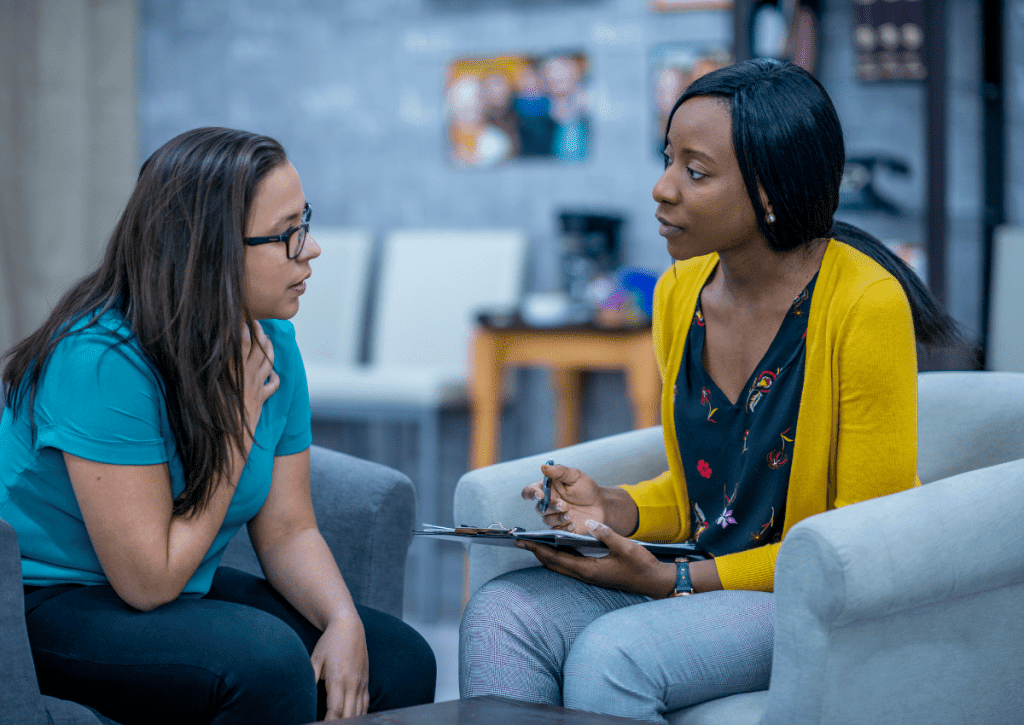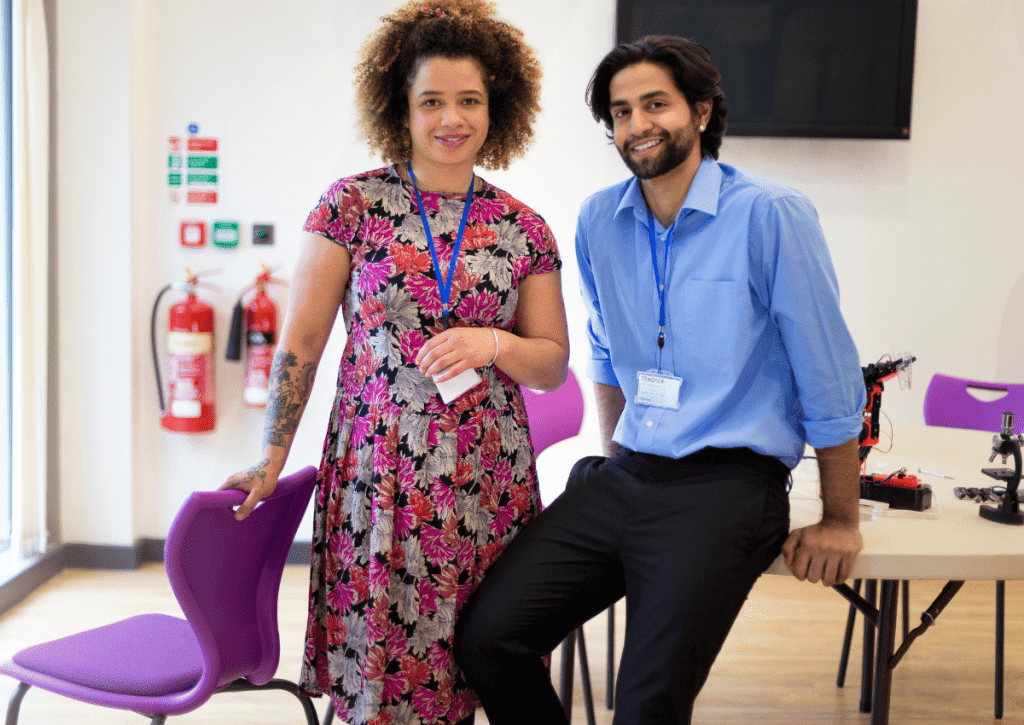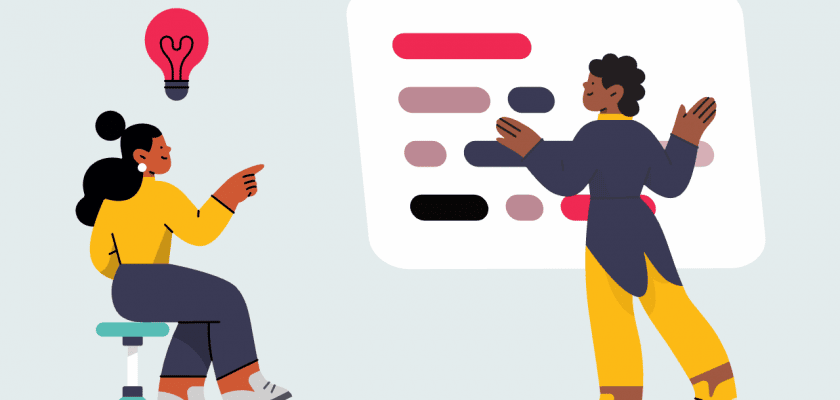I am like any other teacher: in my classroom, lead teaching and learning. I do all the prep and work out how the lesson runs. When I was asked to work with a colleague in a co-teaching situation, it took a little getting used to. Two of us guiding the students was a whole new dynamic we both had to learn.
In this article, we will unpack what co-teaching is, describe the different co-teaching models, and explain why it is beneficial for students, as well as how to go about it effectively.
Table of Contents
- What is Co-Teaching?
- Benefits of co-teaching
- How to make the most of a co-teaching partnership
- Co-teaching models and their effectiveness
- Co-Teaching Models FAQs
- Final thoughts about co-teaching
What is Co-Teaching?
Co-teaching is an approach to teaching and learning in which two teachers are both active in a classroom at the same time. They may be involved in the lesson in different capacities, but are both responsible for planning and delivering the lesson.
The aim of co-teaching is to use the expertise of two teachers to ensure that all the students get the attention they need in creative, effective lessons.

Benefits of co-teaching
Co-teaching gives you the opportunity to collaborate with a colleague, which can help you develop your own teaching.
There are other benefits to this model of teaching too:
The number of students in relation to teachers decreases if you have two teachers in one classroom. This means that the students can get more individual attention. It also means you will get to know your students and their individual needs better.
Co-teaching allows for more teaching and learning time in the long run, because of how the lessons are conducted. This is especially true if sections of the class are able to continue at their own pace. It is also a product of good time management in lessons.
The self-esteem of students who tend to get left behind in class will increase as they find themselves understanding the work better and not feeling as though they are less capable. This is because co-teaching allows at least one of the teachers to recognize the learners who aren’t quite grasping the work and going through it with them to make sure they understand and can apply the information.
When two teachers work together on one lesson, they will have to plan every aspect thoroughly, so that they can deliver the lesson effectively. This means that co-teaching increases the standard of lessons and the depth of preparation. The collaboration also means the teachers will be able to work through the content of the lesson even more thoroughly than on their own.
In a co-teaching situation, the time of a lesson needs to be organized efficiently. This is so the content can all be delivered while taking into account any additional explanation or practice that may be necessary. This encourages teachers to manage their time efficiently, both during the planning and the delivery of the lesson.
The key to effective co-teaching is teamwork and communication. If this approach to education is done effectively, it demonstrates the value of effective teamwork, both to students and to other teachers.
There is not ever only one way of teaching, and definitely not only one way of learning. In fact, just about every student learns in their own way. One of the huge benefits of co-teaching is that you can offer and explore different options for teaching. Then, learners are given more opportunities for learning in different ways and at different speeds.
With co-teaching, the classroom becomes more inclusive. Students with disabilities can be accommodated more easily because there are opportunities for focused and specialized teaching. This means that the students will be part of the general education curriculum.
With different levels and types of support being offered by the two teachers in the classroom, all the students will benefit, not only those who require additional support. The whole class will have access to additional resources and extra support if they need it.
All educators have their own strengths and weaknesses. In a co-teaching situation, individual teachers work together using skills and approaches that complement each other. This inter-relationship creates a richer learning environment for the students.

How to make the most of a co-teaching partnership
Although there is always collaboration between teachers in one grade, or one subject, teaching is essentially a solo profession. Outside the classroom, you operate as part of a team. In the classroom, though, it is you who leads and guides the learning.
Because of this, it’s not always easy for a teacher to share their role with someone else. However, if you are exposed to co-teaching, you will begin to understand the value of employing it at times.
In order to practice this mode of teaching, you need to follow some basic guidelines and approaches.
- Co-teaching is about nothing more than collaboration: two professionals are working together to create a learning situation that uses their relevant strengths in relation to each other. If you can work together, the result will be an effective, inclusive learning experience for the students.
- Teachers who are teaching together must communicate all the time. It is essential that both you and your co-teacher understand the purpose of co-teaching and the focus of the lesson. Be open to discussing, explaining and questioning anything to do with the lesson. You will need to listen to each other and work to solve points together.
- In fact, listening is a vital part of communication. Make sure you listen to what your colleague says and offers. You don’t need to take everything on board, but you do need to know how they are thinking, so you can work on developing the lesson together.
- An important aspect of effective co-teaching is respect. You must respect your co-teacher as a professional who brings knowledge, experience and enthusiasm to the classroom. They will teach differently from you, will have less or more experience in the classroom, or will be older or younger than you. This is the beauty of co-teaching: two individuals with different strengths coming together to guide the students in their learning.
- When you are co-teaching, you and your colleague must plan every aspect of the lesson carefully. Make sure you understand what will happen during the lesson and what your role is. Work together to make sure it is clear what each of you will do in the lesson and what you are each responsible for.
- A lesson that is co-taught is likely to need very focused worksheets and other aids. Don’t expect to do everything on your own. Seek administrative help as necessary.
- As thoroughly as a lesson is planned, in a real classroom situation, something is going to be different from what you expected. You must be able to adapt as the lesson progresses. Sticking to the plan without making adjustments for real life will result in ineffective education.
- Part of the ability to adapt is not taking the lesson and your responsibilities too seriously. Yes, you may have planned the lesson down to the last detail. If you are determined to stick to that and be inflexible, though, you will end up not teaching the students in the way they need to be taught.

Co-teaching models and their effectiveness
Research and practice have identified six approaches to co-teaching. Some of these have one lead teacher, but some rely on teachers working at the same level in the classroom.
Teach and observe
The simplest form of co-teaching is for one teacher to teach and the other to observe. This may sound as though the second teacher does not contribute to the teaching. Contrary to this, however, the observing teacher is actively involved in the overall program of co-teaching.
Their role is to observe the students carefully, to gauge whether learning is taking place and how effective it is. This will help the teachers to work on their planning for future sessions. The observing teacher should also identify any students who are struggling and be able to suggest ways to help them learn.
This approach to co-teaching gives the students one focus and allows the teacher, who is actively teaching, to work on engaging all the students. The value of the observing teacher is that they can focus on the way the students gather knowledge and then apply it, identifying any individuals who need extra help.
Teach and assist
This approach has one lead teacher who teaches the lesson. The second teacher ‘floats’ around the room, making sure that students understand the content and what to do with it.
The role of the second teacher is not so much to assist the lead teacher, but to assist the students in being actively and productively involved in the learning. It is also to help those students who may need extra attention.
This model of co-teaching effectively allows the lead teacher to focus on presenting the content and to go at the class’ overall pace through the lesson. They are secure in the knowledge that students who may not move at quite the same pace as the rest of the class will be getting the help they need. It also encourages individual students who are not keeping up to see help actively.
Parallel teaching
When co-teachers work together, there are opportunities to teach the same content at the same time. The class is divided evenly and each teacher takes responsibility for a group. They will actively teach identical content, but at the pace of their group. They may also employ slightly different methods, if it is appropriate.
This is a particularly effective approach to co-teaching in a class that has two main streams or abilities. Because the groups each teacher works with are smaller, there is more chance for students of all abilities to get more dedicated attention. The teacher can also employ differential teaching with their group as necessary.
In an ideal situation, each teacher can divide their group further into mixed ability pairings or small groups and monitor how the students can help each other.
Teaching stations
Think about the classroom as being a network of steam train tracks, with different sidings. At each spot, something must be done to the engine: filling up the water, re-stocking the supply of coal, changing drivers, checking the brakes etc.
Your classroom can be set up in the same manner – with different spots where teaching can take place. There should be at least two spots, but there could be more. At each spot, or station, one teacher will offer instruction, guidance or assessment in relation to one aspect of the lesson being taught. If the lesson has more than two aspects, the co-teachers can move stations, as the students work through the lesson.
Alternative teaching
All students learn differently. However, generally, most of the students in one class will learn adequately if they are taught in a similar manner. In any class, there are inevitably students who don’t quite follow the same mode as their peers. In this co-teaching model, one teacher will teach most of the students, while the other teacher will take the smaller group of students needing alternative teaching and guide them through the content.
This approach to co-teaching is effective in that it decreases the size of the group each teacher is working with. Even though one teacher will have a bigger group than the other, it will still be smaller than teaching the whole class together.
It is also effective because it allows all students the same opportunity to learn, while acknowledging that individuals may learn differently. On another level, by encouraging teachers to find alternative ways of teaching, it helps to keep their teaching interesting and alive.
Group teaching
Group or team teaching is possibly the most demanding model of co-teaching. Both teachers are expected to deliver the lesson, while relying on, and respecting, their colleague and their teaching. Both teachers are equally responsible for delivering, monitoring and adjusting the lesson. They need to dovetail as they teach and make sure the students receive a consistent standard of education.
This is the model of co-teaching that demands the most preparation, because the teachers need to make sure that everything works together and complements each other. They must be on the same page before, during and after the lesson.
This model may be demanding, but it is also effective, because the students are receiving the best expert input and help they can get in that subject at that time.
Co-Teaching Models FAQs
Having two teachers in the classroom does not necessarily mean that the students will learn any more effectively than if they are taught by a single teacher. With two teachers active in the classroom at one time, co-teaching does mean that students can get more attention than in a single-teacher classroom.
The term ‘team of teachers’ refers to a group of teachers that work together. They will usually be teaching the same grade or subject, or may be marking assessments together. The term ‘co-teachers’ refers to two teachers who teach a lesson together and who are both responsible for the teaching and learning that happens.
Teachers are used to working alone and can find it challenging to have to plan a whole lesson with another teacher. It is also a challenge to work on allocating different roles in the classroom. Another challenge for teachers is to share the actual teaching.
Final thoughts about co-teaching
Co-teaching models allow some of the most valuable and rewarding teaching and learning. Co-teaching models offer different approaches to teaching, where two teachers are responsible for the lesson. By working together, the teachers offer the students more in-depth and individual attention, for both teachers and students. It is also the best way to ensure genuine inclusivity and student-driven learning in your class. Co-teaching is not just about two teachers sharing a class. It’s about two professionals with different focuses and skill sets guiding students to learn and apply what is being taught
